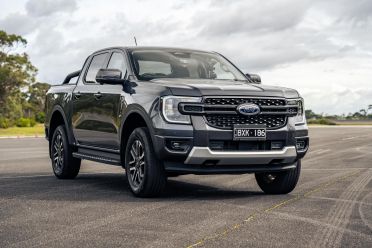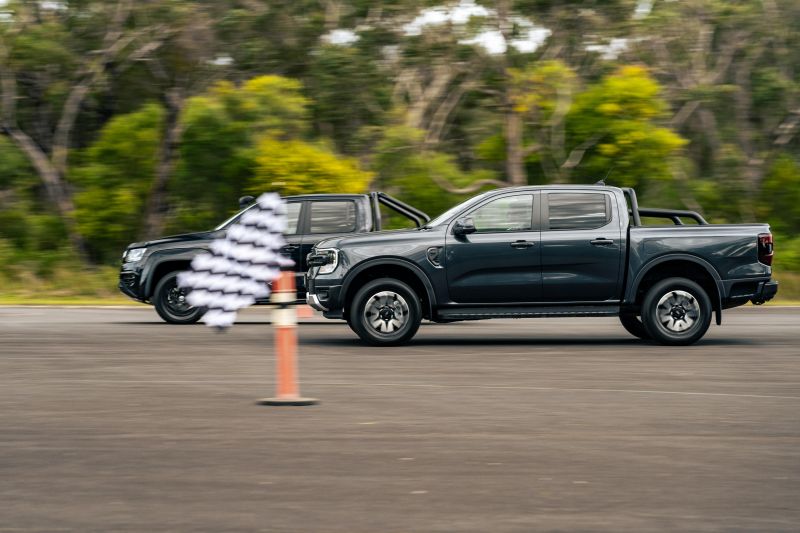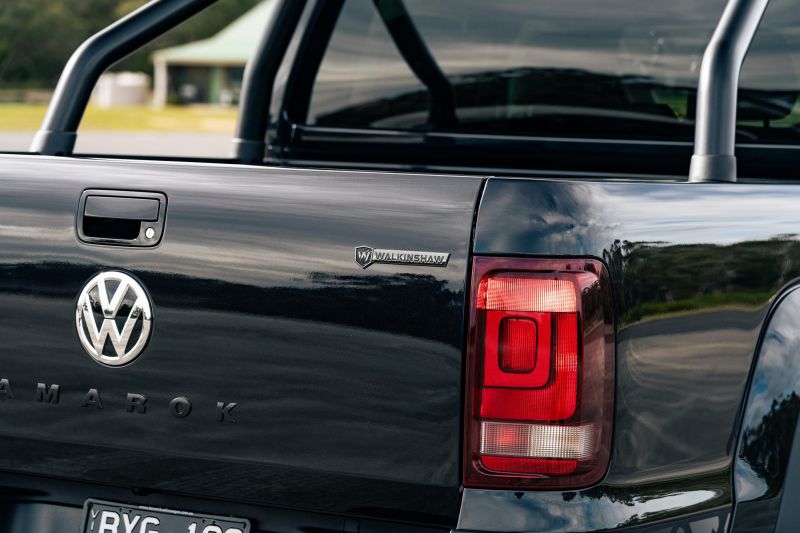The new Ford Ranger has a V6 engine option for the first time, but it’s not the only dual-cab ute to ditch the traditional four-cylinder turbo-diesel formula in search of more grunt.
The outgoing Volkswagen Amarok has packed a V6 punch since 2017, and its 3.0-litre turbo-diesel actually packs more power than the Ranger’s in TDI580 guise.
Throw in the fact the new Amarok will use the same engine as the Ranger, and you can see why we were so keen to get this pair side-by-side.
The two cars on test here are the Ranger Sport V6, a mid-to-high specification car, and the Walkinshaw-fettled Amarok W580X.
Given the Amarok is approaching the end of its life, the off-road oriented W580X was the only version we were able to lay our hands on. Thank you to Berwick Volkswagen for providing the car, and allowing us to put it through its paces.
Here, Paul puts the Ranger and Amarok head-to-head in a series of challenges. Watch the video above, or check it out on our YouTube channel.
Ford Ranger V6 v Amarok V6 tests
Paul and the crew put this pair against several test procedures:
- A basic sound comparison, seeing which has the best exhaust note
- Multiple 0-100km/h times for both
- Head-to-head drag race over 1/8 mile
- Head-to-head drag race over 1/8 mile with passenger in Amarok
- Earlier 1/4 mile comparative sprints
The Amarok was running on AT tyres, and the Ranger was running HT tyres. We understand an apples-for-apples comparison with the same rubber would be even better, but given where the Amarok is in its life this was the car we could get.
| Ford Ranger Sport V6 | Volkswagen Amarok W580X | |
|---|---|---|
| Engine | 3.0L V6 turbo-diesel | 3.0L V6 turbo-diesel |
| Power | 184kW | 190kW (200kW overboost) |
| Torque | 600Nm | 580Nm |
| Transmission | 10-speed AT | Eight-speed AT |
| 4×4 system | Full-time | Full-time |
| Tare mass | 2282kg | 2227kg |
Ford Ranger V6 engine specifications
The 3.0-litre V6 single-turbo diesel is offered in the Ranger XLT and above, making 184kW of power at 3250rpm and 600Nm torque from 1750rpm. It’s mated to a 10-speed automatic.
It runs a permanent 4×4 system with road-oriented ‘4A’ AWD as well as traditional 2H (rear-drive for fuel saving), 4H (high-range) and 4L (low-range) modes as well.
This engine, dubbed Lion, is derived from the one in the Ford F-150, but fitting it to the smaller Ranger presented some packaging challenges. Ford Australia changed the oil pan, prepared it for greater tilt angles, changed the turbo and intakes, and tested it all over again.
Volkswagen Amarok V6 specifications
The Amarok is offered with a choice of four-cylinder or V6 power in 2022.
The 3.0-litre single-turbo V6 oiler is offered in three states of tune, most powerful of which is on test here. On overboost it makes 200kW of power and 580Nm of torque between 1400rpm and 3000rpm – in normal driving peak power is 190kW at 4500rpm.
It runs a permanent 4×4 system which, unlike the Ranger, can’t be locked into rear-wheel drive. The Amarok V6 runs an eight-speed automatic transmission.
Ford Ranger V6 v Volkswagen Amarok V6 performance figures
Best times listed. For the full list, watch our video.
| Ranger Sport V6 | Volkswagen Amarok W580X | |
|---|---|---|
| 0-100km/h | 8.2s | 7.9s |
| 1/8 mile | 10.5s @ 113.8km/h | 10.2s @ 114.9km/h |
| 1/4 mile | 16.1s @ 140.0km/h | 15.9s @ 138.9km/h |
Verdict
The older Amarok is quicker than the new Ranger.
It’s 0.3 seconds quicker to 100km/h despite its AT tyres, 0.3 seconds quicker over the 1/8 mile, and 0.2 seconds quicker over the 1/4 mile.
Loading a passenger in the Amarok narrowed the gap, but it wasn’t quite enough to hand the Ranger a win.
MORE REVIEWS: 2023 Ford Ranger review
MORE REVIEWS: 2023 Ford Ranger Sport V6 review
MORE REVIEWS: 2022 Volkswagen Amarok W580X review










